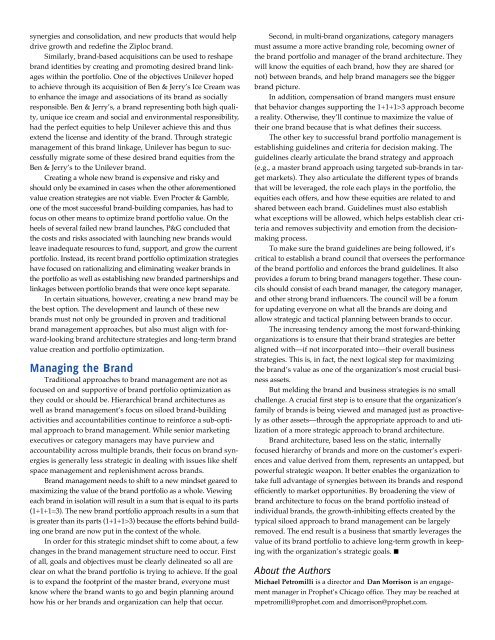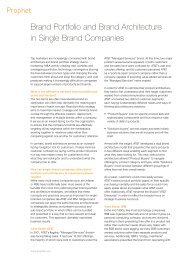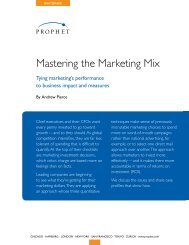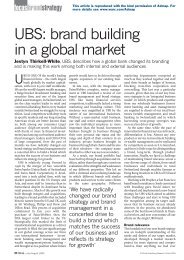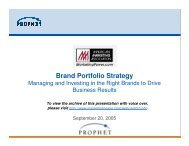Download - Prophet
Download - Prophet
Download - Prophet
You also want an ePaper? Increase the reach of your titles
YUMPU automatically turns print PDFs into web optimized ePapers that Google loves.
synergies and consolidation, and new products that would help<br />
drive growth and redefine the Ziploc brand.<br />
Similarly, brand-based acquisitions can be used to reshape<br />
brand identities by creating and promoting desired brand linkages<br />
within the portfolio. One of the objectives Unilever hoped<br />
to achieve through its acquisition of Ben & Jerry’s Ice Cream was<br />
to enhance the image and associations of its brand as socially<br />
responsible. Ben & Jerry’s, a brand representing both high quality,<br />
unique ice cream and social and environmental responsibility,<br />
had the perfect equities to help Unilever achieve this and thus<br />
extend the license and identity of the brand. Through strategic<br />
management of this brand linkage, Unilever has begun to successfully<br />
migrate some of these desired brand equities from the<br />
Ben & Jerry’s to the Unilever brand.<br />
C reating a whole new brand is expensive and risky and<br />
should only be examined in cases when the other afore m e n t i o n e d<br />
value creation strategies are not viable. Even Procter & Gamble,<br />
one of the most successful brand-building companies, has had to<br />
focus on other means to optimize brand portfolio value. On the<br />
heels of several failed new brand launches, P&G concluded that<br />
the costs and risks associated with launching new brands would<br />
leave inadequate re s o u rces to fund, support, and grow the curre n t<br />
portfolio. Instead, its recent brand portfolio optimization strategies<br />
have focused on rationalizing and eliminating weaker brands in<br />
the portfolio as well as establishing new branded partnerships and<br />
linkages between portfolio brands that were once kept separate.<br />
In certain situations, however, creating a new brand may be<br />
the best option. The development and launch of these new<br />
brands must not only be grounded in proven and traditional<br />
brand management approaches, but also must align with forward-looking<br />
brand architecture strategies and long-term brand<br />
value creation and portfolio optimization.<br />
Managing the Brand<br />
Traditional approaches to brand management are not as<br />
focused on and supportive of brand portfolio optimization as<br />
they could or should be. Hierarchical brand arc h i t e c t u res as<br />
well as brand management’s focus on siloed brand-building<br />
activities and accountabilities continue to re i n f o rce a sub-optimal<br />
approach to brand management. While senior marketing<br />
executives or category managers may have purview and<br />
accountability across multiple brands, their focus on brand syne<br />
rgies is generally less strategic in dealing with issues like shelf<br />
space management and replenishment across brands.<br />
Brand management needs to shift to a new mindset geared to<br />
maximizing the value of the brand portfolio as a whole. Vi e w i n g<br />
each brand in isolation will result in a sum that is equal to its parts<br />
(1+1+1=3). The new brand portfolio approach results in a sum that<br />
is greater than its parts (1+1+1>3) because the efforts behind building<br />
one brand are now put in the context of the whole.<br />
In order for this strategic mindset shift to come about, a few<br />
changes in the brand management structure need to occur. First<br />
of all, goals and objectives must be clearly delineated so all are<br />
clear on what the brand portfolio is trying to achieve. If the goal<br />
is to expand the footprint of the master brand, everyone must<br />
know where the brand wants to go and begin planning around<br />
how his or her brands and organization can help that occur.<br />
Second, in multi-brand organizations, category managers<br />
must assume a more active branding role, becoming owner of<br />
the brand portfolio and manager of the brand architecture. They<br />
will know the equities of each brand, how they are shared (or<br />
not) between brands, and help brand managers see the bigger<br />
brand picture.<br />
In addition, compensation of brand mangers must ensure<br />
that behavior changes supporting the 1+1+1>3 approach become<br />
a reality. Otherwise, they’ll continue to maximize the value of<br />
their one brand because that is what defines their success.<br />
The other key to successful brand portfolio management is<br />
establishing guidelines and criteria for decision making. The<br />
guidelines clearly articulate the brand strategy and appro a c h<br />
(e.g., a master brand approach using targeted sub-brands in target<br />
markets). They also articulate the diff e rent types of brands<br />
that will be leveraged, the role each plays in the portfolio, the<br />
equities each offers, and how these equities are related to and<br />
s h a red between each brand. Guidelines must also establish<br />
what exceptions will be allowed, which helps establish clear criteria<br />
and removes subjectivity and emotion from the decisionmaking<br />
pro c e s s .<br />
To make sure the brand guidelines are being followed, it’s<br />
critical to establish a brand council that oversees the performance<br />
of the brand portfolio and enforces the brand guidelines. It also<br />
p rovides a forum to bring brand managers together. These councils<br />
should consist of each brand manager, the category manager,<br />
and other strong brand influencers. The council will be a foru m<br />
for updating everyone on what all the brands are doing and<br />
allow strategic and tactical planning between brands to occur.<br />
The increasing tendency among the most forward-thinking<br />
organizations is to ensure that their brand strategies are better<br />
aligned with––if not incorporated into––their overall business<br />
strategies. This is, in fact, the next logical step for maximizing<br />
the brand’s value as one of the organization’s most crucial business<br />
assets.<br />
But melding the brand and business strategies is no small<br />
challenge. A crucial first step is to ensure that the organization’s<br />
family of brands is being viewed and managed just as proactively<br />
as other assets––through the appropriate approach to and utilization<br />
of a more strategic approach to brand architecture.<br />
Brand architecture, based less on the static, internally<br />
focused hierarchy of brands and more on the customer’s experiences<br />
and value derived from them, represents an untapped, but<br />
powerful strategic weapon. It better enables the organization to<br />
take full advantage of synergies between its brands and respond<br />
efficiently to market opportunities. By broadening the view of<br />
brand architecture to focus on the brand portfolio instead of<br />
individual brands, the growth-inhibiting effects created by the<br />
typical siloed approach to brand management can be largely<br />
removed. The end result is a business that smartly leverages the<br />
value of its brand portfolio to achieve long-term growth in keeping<br />
with the organization’s strategic goals. ■<br />
About the Authors<br />
Michael Petromilli is a director and Dan Morrison is an engagement<br />
manager in <strong>Prophet</strong>’s Chicago office. They may be reached at<br />
mpetromilli@prophet.com and dmorrison@prophet.com.


